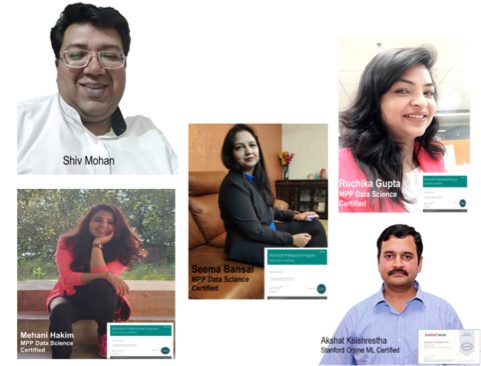Centric India’s Ruchika Gupta shares her journey from Netflix fan wondering about her recommendations list to competitive machine learning (ML) team member.
Hello, and welcome to my machine learning (ML) journey. In this blog post, I will walk you through my process of becoming part of a team of ML enthusiasts competing at Centric Consulting’s 2020 Expedition: Data event.
By sharing how I started, the effort my team and I put into learning ML, and the challenges we faced along the way, I hope to inspire you to take the first steps toward starting your own ML journey.
A software engineer by education, I currently work as a data integration (DI) tester for Centric India. Previously, I was a mainframe developer. My recent interest in the new and emerging field of ML comes from my firm belief that you deserve a career and a life you love and enjoy — and I love and enjoy ML.
Why Machine Learning?
I have always been fascinated by technology’s extensive growth and possibilities. It has allowed us to travel from a belief that “No one knows tomorrow” to “Yes, we can predict tomorrow,” because, in some ways, we can almost predict the future.
Predictive analytics have found widespread applications in things we take for granted every day, such as weather forecasting, growth prediction of stocks, financial modeling and sales forecasting. But what sparked my interest is something even more familiar: Netflix. I became fascinated by ML because I wanted to know more about how Netflix determined which movies to recommend to me.
Introduction to Machine Learning
Let’s begin by breaking down what machine learning is and how it will shape tomorrow.
ML is the most popular technique for classifying information to help people make decisions. ML algorithms train over instances, or examples, through which the cases learn from past experiences and analyze historical data.
Without explicit programming, machine learning technology uses learning algorithms to organize enormous amounts of data into information and services based on certain instructions and rules. Unlike traditional programming, ML programs – not people — create the rules by learning algorithms. But, as my Centric India colleague Amanpreet Singh has noted, ML cannot work without a lot of human thought first.
Where Did My Journey Begin?
“The starting point of all achievement is desire.” — Napoleon Hill
Sometimes the best way to start something new is to, well, start.
In January 2019, my peers and I engaged in various learning initiatives as part of a Center of Excellence (COE) program. During one of the team meetings, the group leaders asked for volunteers to learn ML and become Microsoft ML certified.
I, along with my colleagues Seema Bansal and Mehani Hakim, raised our hands. In no time, we received approval and sealed our fate for the next six-to-eight months. This is how I joined two wonderful learning partners, and we became a team of three musketeers.
While signing up for the initiative was easy, moving forward required a lot of dedication, focused efforts and time. It was particularly challenging for us because of our existing personal and professional commitments.
We started by enrolling ourselves in the EDX Data Science Machine Learning course, recommended by one of our colleagues. The course contains 11 modules, and as a part of our training, we explored topics such as Azure Machine Learning Studio, Power BI reporting, various research methods, and mathematical formulae and algorithms.
One by one, we completed all the modules, took our exams and earned our certificates. These were the stepping-stone towards the final Microsoft certification in ML, which required us to complete a small project.
Many times, my morale slipped because of my other priorities. But with motivation from each other and some collaborative efforts, the three of us succeeded, earning our certifications by September 2019. Our efforts yielded the desired result, and we were thrilled and proud.
Time for Some Hands-On Experience
We developed a thorough understanding of the relevant concepts, and now it was time for us to work on a live project. However, we didn’t have any available projects, and it seemed like we would have to wait for some time before anything developed for our ML work. And after only a month, we realized none of us wanted to lose touch with ML, so we decided to practice coding.
The best platform we came across for coding was Kaggle. We picked up a couple of problem cases and tried to code ourselves using Python in Jupyter Notebook. This work helped us gain a practical understanding of various ML concepts we had studied in our certification courses.
The Journey to Expedition: Data
The start of 2020 presented an exciting opportunity for machine learning that we knew would make our journey even richer with new learning and adventure.
The opportunity was an internal event called Expedition: Data, taking place in the U.S. at our annual spring meeting in St. Louis, Missouri. As soon as we learned about it at one of our COE sessions, our hearts skipped a beat. Expedition: Data incorporates different challenges related to data visualization and ML. This would be our chance to shine, so Seema, Mehani and I signed up. Later two other members, Shiv Mohan and Akshat Kulshrestha, joined our team. Each member brought a different skill set:
- I brought my multi-technology experience in mainframe development, DI testing, and data and analytics (D&A). I was highly motivated to put forth my best effort.
- Seema has a strong testing and D&A background. We knew her D&A experience would be icing on the cake as we prepared to analyze every challenge and solution we anticipated.
- Mehani had worked on various development projects, and we were eager to leverage her knowledge and development experience in the best possible way.
- Shiv was one of the most experienced members, with a rich D&A background. We knew his guidance and patience would bring out the best in us and take the team spirit in the right direction.
- Akshat, a mainframe developer, was also a keen learner of ML. He was well versed in ML Studio and Auto ML. We knew bringing his more in-depth experience in Python, Jupyter Notebook and Automated ML would help the team.
With our team, Centric India1, assembled, the five of us began on our ML journey, full of enthusiasm and ready to succeed at Expedition: Data.

Our Machine Learning Challenge
The organizers of Expedition: Data gave us six business problems to choose from. They revolved around critical issues such as customer retention, consultant retention and strategist retention. After reviewing the materials and considering the options, we decided on consultant retention. The problem’s definition was to develop a machine learning model that would help our participating client:
- Hire and invest in training new consultants and salespeople
- Lower attrition for existing consultants and salespeople
- Benefit from potential areas for leadership coaching by analyzing data from daily activities such as emails sent, appointments set or kept, or leads entered into the database
- Recognize opportunities to “coach up” or “coach out.”
From a consultant-retention perspective, our task was to identify the characteristics of consultants at risk of leaving the firm, and our goal was to develop ML and data-science-based retention programs for those consultants.
In our project, we had to demonstrate our capability using Microsoft ML technologies such as Azure ML Services, Azure ML Virtual Machine and Azure Databricks. We had some knowledge about these tools, but we needed to explore them more deeply. The client partnering with us for this project provided their data through a SQL database. After securing all the required accesses and familiarizing ourselves with the tools, we were ready to move forward.
In my next post, I’ll take a deeper look at how we analyzed our problem and built our ML model to solve it — and, of course, how it performed and how Centric India1 did at Expedition: Data.
It’s Just the Beginning
In a short time, I went from wondering about machine learning and Netflix to becoming ML certified and joining a team ready to tackle a real-world problem. Thank you for joining me on my ML journey. I can’t wait to share what’s next.


